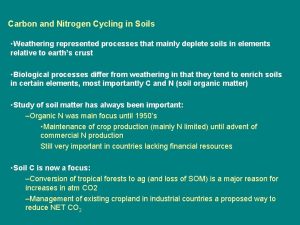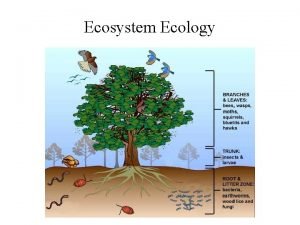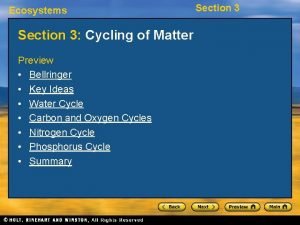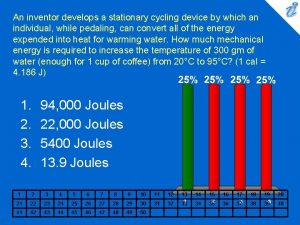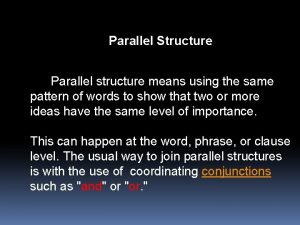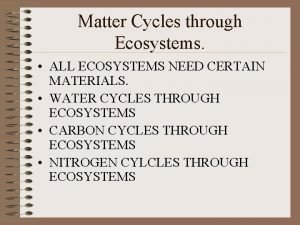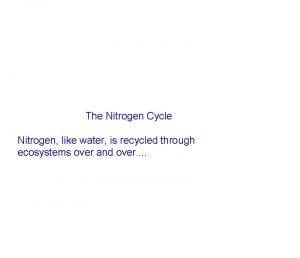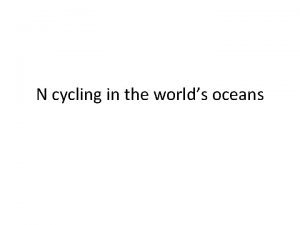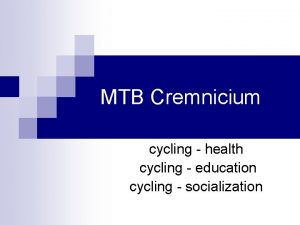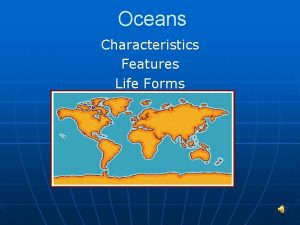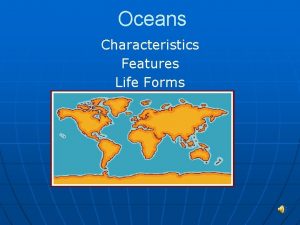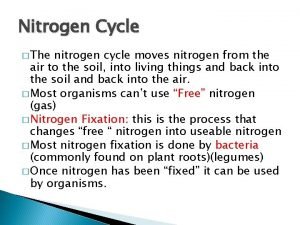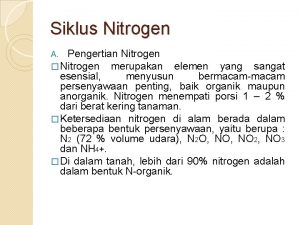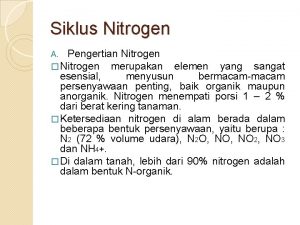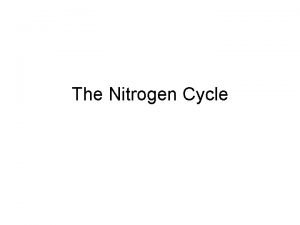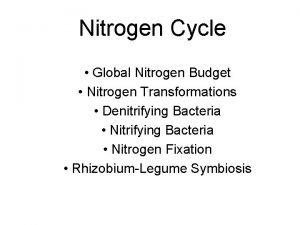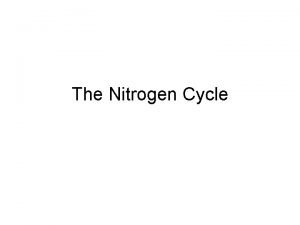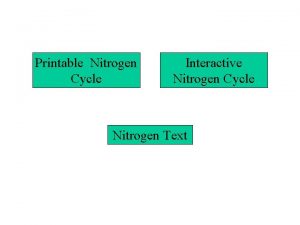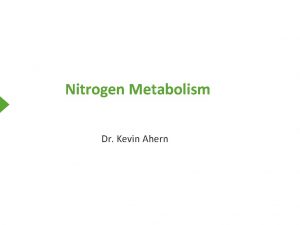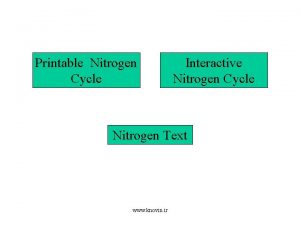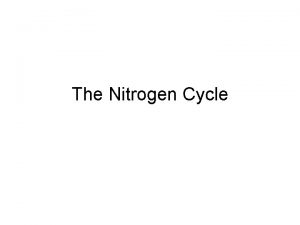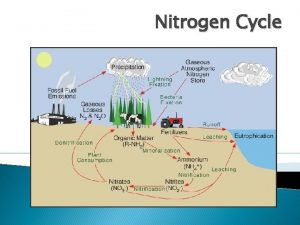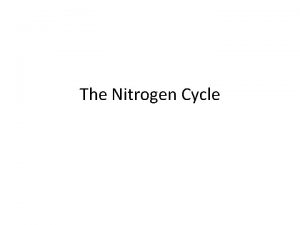N cycling in the worlds oceans Nitrogen n



















- Slides: 19

N cycling in the world’s oceans

Nitrogen n N is an essential nutrient for all living organisms (nucleic acids and amino acids) N has many oxidation states, which makes speciation and redox chemistry very interesting NH 4+ is preferred N nutrient

Marine N Libes, 1992 Bioavailable/Fixed (oxidation state) NO 3 - 5. 7*105 Tg N (+5) NO 2 - 500 Tg N (+3) NH 4+ 7. 0*103 Tg N (-3) Organic N 5. 3*105 Tg N (-3) Non-bioavailable N 2 O 200 Tg N (+1) N 2 2. 2*107 Tg N (0)

Marine Fixed N Budget Codispoti et al. (2001) Marine Reservoir: 6. 3*105 Tg N Sources: 287 Tg N/yr Sinks: 482 Tg N/yr Atmospheric deposition: 86 Tg N/yr N 2 O loss: 6 Tg N/yr N 2 fixation: 125 Tg N/yr Water Column denitrification: 150 Tg N/yr River Input: 76 Tg N/yr Organic N export: 1 Tg N/yr Sedimentation: 25 Tg N/yr Benthic denitrification: 300 Tg N/yr

Fixation N 2 Nitrification NH 4 NO 3 Uptake Phytoplankton Grazing Chlorophyll Zooplankton Mortality Water column Mineralization Susp. particles Large detritus Nitrification N 2 NH 4 Denitrification Sediment Organic matter NO 3 Aerobic mineralization

Nitrogen Cycle http: //www. petsforum. com/personal/trevor-jones/nitrogencycle. gif

Organic Matter Oxidation Sequence Respiration Morel & Herring, 1993 ΔG° (k. J/mol) -119 Denitrification -113 Mn. O 2 reduction -96. 9 Fe oxide reduction -46. 7 Sulfate reduction -20. 5 Methanogenesis -17. 7

Alternative pathways to N 2 Microbially mediated Nitrification Anammox Heterotrophic Denitrification Nitrogen Fixation Chemical Reactions Mn. O 2 Reduction Mn 2+ Oxidation OLAND

Marine Fixed N Budget Unbalanced WHY? ? ? ? ? ? n n n N Fixation may have been underestimated Limited data on Trichodesmium and other N fixers; variability in abundances and fixation rates of organisms Recent estimates of N fixation rates have increased (Gruber and Sarmiento, 1997; Karl et al. , 1997) Denitrification may have been overestimated Stoichiometric and model-based estimates used; limited data on direct denitrification measurements

My research n Denitrification describes the removal of fixed N, mostly NO 3 -, resulting in the formation of non-biologically available N, primarily N 2 gas n Continental shelf sediments are responsible for up to 67% of marine denitrification estimates Sandy sediments comprise 70% of continental shelves; global estimates of denitrification are mostly based on muddy sediments Sands contain less organic matter and nutrients, and high oxygen concentrations in overlying water n n

Benthic primary production (BPP) n n n Sandy sediments have low organic matter content, substrate for heterotrophic denitrification BPP supplies reactive organic matter through remineralization Organisms compete with microbes for nutrients such as NH 4+ Organisms also produce oxygen during photosynthesis Role of BPP remains unclear

Isotope tracer experiments A. Experiment 1 14 N POM 1 E 1 A 15 NH +, 4 14 NO 3 1 F 1 B 15 NO 3 14 N 15 N, 15 N 1 C 1 D 15 N 14 N 15 N B. Experiment 2 15 N 2 E 15 NO -, 3 14 NH + 4 2 A 14 NO 3 2 C POM 2 F 2 D 14 N 14 N 15 N 2 B 14 N 15 N, 14 N Possible outcomes of amendment experiments. 1 A = Aerobic nitrification of 15 NH 4+; 1 B = Heterotrophic denitrification with 14 NO 3 - and/or 15 NO 3 -; 1 C = OLAND with 15 NH 4+ or partial nitrate reduction to nitrite followed by anammox with 15 NH 4+; 1 D = Same as 1 C except with standard nitrate; 1 E = Heterotrophic denitrification with standard nitrate; 1 F = Assimilation. 2 A = Aerobic nitrification of standard ammonium; 2 B = Heterotrophic denitrification with 14 NO 3 - and/or 15 NO 3 -; 2 C = OLAND with standard ammonium or partial nitrate reduction to nitrite followed by anammox with standard ammonium; 2 D = Same as 2 C except with 15 NO 3 -; 2 E = Heterotrophic denitrification of 15 NO 3 -; 1 F = Assimilation

Sampling

Membrane Inlet Mass Spec. (MIMS)

Results n n W 27 and Experiment 2 results suggest the presence of denitrification Experiment 1 results suggest that within the 48 -hr timescale of the experiment, no alternative pathway to N 2 exists in these sediments

Denitrification Rates n n n W 27 Experiment provided a rate of 21. 6 µmole N m-2 d-1 R 4 -Experiment 2 provided rates of 22. 8 & 23. 2 µmole N m-2 d-1 Rates obtained from other continental shelf studies of denitrification yielded 700 -3200 µmole N m-2 d-1 Other continental shelf sites studied contain higher organic matter content than Georgia sediments Georgia continental shelf sediments are oxic to at least 1 -cm depth, thus inhibiting higher rates of denitrification

Discussion of results n n Sandy, continental shelf sediments are potentially important sites of denitrification that may have been overlooked These environments may have similar rates to current study site and if so, similar techniques can be used to measure such low rates of denitrification Denitrification was not completely inhibited by low organic matter content or benthic primary production BPP varies seasonally and spatially, yet denitrification rates were very close between two different stations during different seasons

Future work n n n Impact of BPP can be explored further by monitoring nutrient and dissolved O 2 concentrations and benthic primary production rates (monitored by SABSOON) Compare rates to Gulf of Mexico shelf denitrification rates (Nov. – Dec. 2004) Further explore the presence of alternative pathways in salt marsh sediments by using isotope tracers, 15 N isotopic analyses, and Hg. Cl 2 (Oct. – Nov. 2004)

Future work (cont’d)
 Carbon and nitrogen cycling in soil:
Carbon and nitrogen cycling in soil: Slides
Slides Energy flow and material cycling in ecosystem
Energy flow and material cycling in ecosystem Mary likes hiking swimming and to ride a bicycle
Mary likes hiking swimming and to ride a bicycle In 1896 arbiters of fashion a specific costume for cycling
In 1896 arbiters of fashion a specific costume for cycling Guide to cycling
Guide to cycling Fixed orifice tube system
Fixed orifice tube system Principles of ecology section 3 cycling of matter
Principles of ecology section 3 cycling of matter Section 3 cycling of matter
Section 3 cycling of matter An inventor develops a stationary cycling device
An inventor develops a stationary cycling device Castleknock cycling club
Castleknock cycling club Cycling event sponsorship proposal
Cycling event sponsorship proposal Biogeochemical cycling ensures that
Biogeochemical cycling ensures that Mary likes hiking swimming and cycling
Mary likes hiking swimming and cycling Cycling to work
Cycling to work Matter cycling in ecosystems
Matter cycling in ecosystems Agroecosystem concept
Agroecosystem concept Quantitative research about cycling
Quantitative research about cycling How does carbon enter the atmosphere
How does carbon enter the atmosphere Cycling seniors
Cycling seniors
